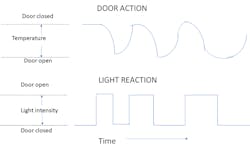Answering the Question: Does a Refrigerator Light Go Out When Door Closes?
This article is part of our April 1st series.
You can also download the PDF eBook of this series.
Among life’s many little questions is this one often asked by children (and others): Does the refrigerator light really go out when the door is closed? A high-school student who prefers to remain anonymous has devised a high-tech way to answer the question as a project for the local science fair.
The project is based on a small sensor-laden device (Fig. 1). The dual-channel data-acquisition system consists of a small, low-power microcontroller with integral signal conditioning, a two-channel multiplexer, and analog-to-digital converter clocked at very low sampling rate (this is a very low-speed application). Its role is simple: Record changes in refrigerator door and internal light states.
To save power, the device stays in quiescent mode until it’s triggered by a change in the open/close status of the refrigerator door or the on/off intensity of internal LED bulb. The door status is determined by measuring the refrigerator’s internal temperature, which undergoes a small but distinct drop when the door opens, and a slower complementary rise when it closes.
Why use temperature? By utilizing a small solid-state transducer, it’s a low-cost, low-power way to sense temperature changes of a few degrees, and is fairly tolerant of positioning as long as the sensor is near the door. The embedded algorithm only looks for small shifts in temperature due to door opening/closing, not the larger slow-moving ones that would be associated with the normal closed-loop, thermal set-point control.
Alternatives such as a mechanical microswitch or proximity sensor like a Hall-effect device were considered, but they would be more difficult to position and install. Similarly, an ultrasonic scheme would demand more power with critical alignment. Sensing the status of the internal light is much more straightforward, and a simple phototransistor is all that’s needed.
Power comes from a single rechargeable AA battery, which is charged externally to simplify the design and just replace as needed. One of the challenges for the design bill-of-materials was to find a battery that retained much of its energy capacity (mAh) and be able to deliver power even at the relatively low temperatures in the refrigerator, which ranged between 34 and 38°F (1 and 3°C) with the door closed.
Another interesting challenge was how to retrieve the door/light data. Since the refrigerator is a sealed metal box, a real-time connection via Bluetooth Low Energy (BLE), other low-power short-range link, or infrared (IR) link wasn’t an option. Instead of having real-time data transfer, the data is uploaded to a smartphone when the unit is removed from the refrigerator, a transfer that’s initiated with the push of a single button on the case.
In turn, the smartphone has an app (also written by the project student) that analyzed the data and processed it to create an on-screen strip chart; the chart visually shows the relationship between door and light status (Fig. 2).
There’s no news on whether this science-fair entry won any sort of prize, but attendees did comment on how it employed new technology to answer a long-time nagging question.
Read more articles like this in our April 1st series in the Humor section of our Series Library.


